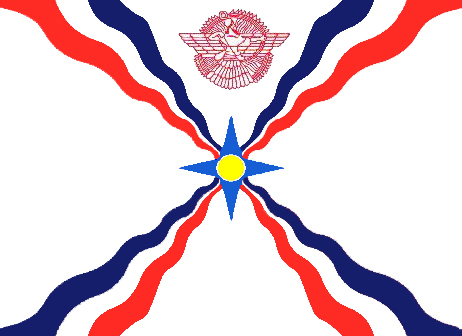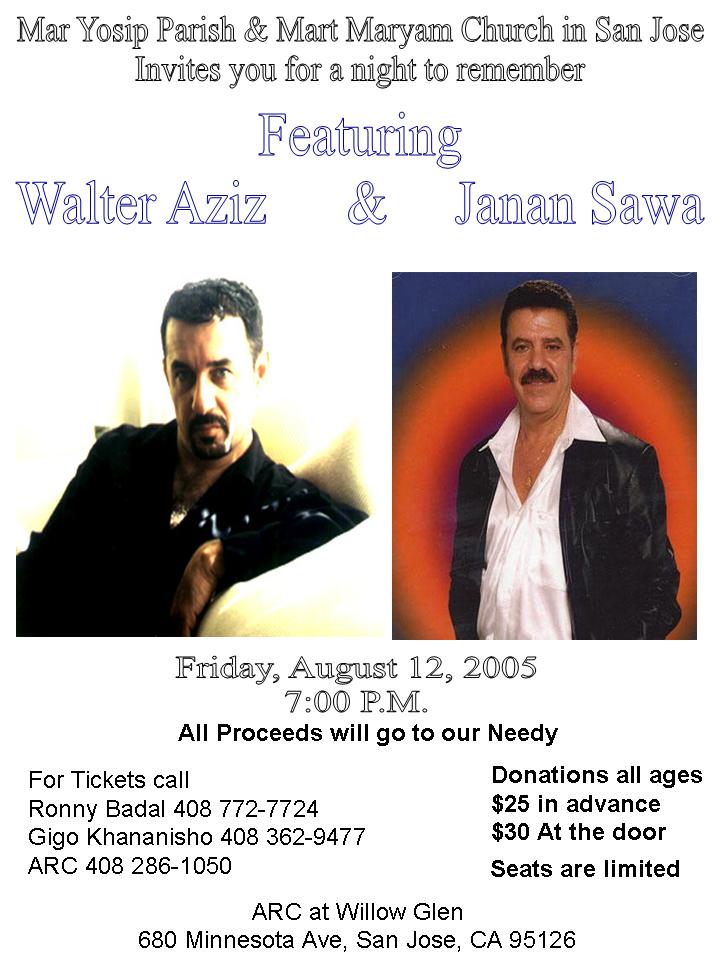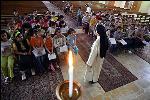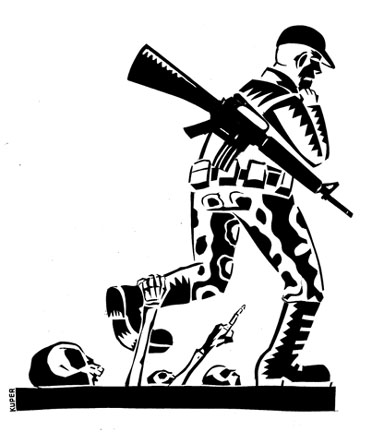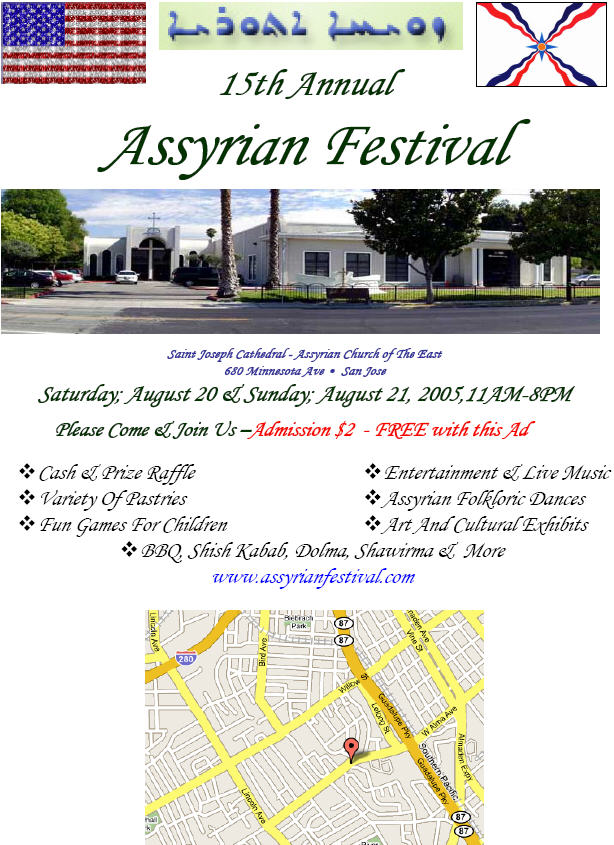The Assyrians: Their Past & the Saga of their Continuity
The following is the full text of the speech given by Mr. Fred Aprim at the Commonwealth Club of California in San Francisco on Tuesday, August 9, 2005.
Fred Aprim
California
Good Afternoon
I want to thank Prof. Dwight Simpson and the Commonwealth Club for giving me this opportunity to talk about my book and I want to thank you all for coming.
Before I begin, let me give you two pieces of news, both good. First, I am not going to burden you with our 4000 years history; however, I will briefly give you my perspective on the Assyrian Odyssey as I presented it in my book. The second is that none of the bad news related to the Middle East could be blamed on Assyrians, since for the world Assyrians do not exist. Therefore, you should feel safe and relaxed.
In the first part of my presentation, I will give a brief description about the Assyrians, their homeland, language, and population. I will then talk a little about my book on the Assyrian continuity. Finally, I will address the present situation of the Assyrians and what the future may holds for them.
Who are the Assyrians?
The Assyrians are remnants of the people of the ancient Mesopotamia, succeeding the ancient Assyrians as one continuous civilization. They are among the first nations, outside of Palestine, who accepted Christianity. They belong to one of the following four churches: the Chaldean Catholic Church, the Syrian Orthodox Church, the Syrian Catholic Church and the Assyrian Church of the East. Due to western missionary work in Assyrian regions in the 19th century, we now also have western-style Assyrian Protestant Churches as well. Assyrians are also known by their religious designations such as Nestorians, Chaldeans, and Jacobites or Suryan.
Where is Assyria?
Assyria includes the modern regions of northern Iraq, southeast Turkey, northeast Syria, and northwest Iran. The heartland of Assyria is its four capitals: Ashur, Dur Sharukin (Kalah), Nimrod (Khorsabad), and finally Nineveh in north of Iraq. After the fall of Nineveh in 612 B.C., the Assyrians built new settlements on the opposite side of the Tigris River, which became today's Mosul. The name Mosul remains in use today. During the rule of the Ottoman Turks of today's region of Iraq, which began from around the 17th century and until World War I, north of Iraq was known as Mosul Province.
Today, the historic names of Assyria and Mosul are in the process of being transformed to Kurdistan, i.e. the land of the Kurds. In my book, I provide some figures that reflect the population of many predominantly Assyrian regions in northern Mesopotamia during the last 150 years. I show how Kurds have slowly moved and occupied these Christian dominated regions and how the populations of Kurds increased in cities like Diyar Bakir and Mardin in southeast Turkey and in Mosul, Iraq while that of the Assyrians decreased.
Contributions to world civilizations
The Assyrians have contributed much to world civilizations. Allow me to give these few examples:
1. The Mesopotamian and Assyrian mythology gave much to Christianity. The Assyrian Christians of today are the same people who earlier worshiped the deity Ashur, the name of Assyrians' supreme god. If we study the Assyrian prophecy corpus, published first in 1875 by George Smith, we would see amazing parallels between the Old Testament prophecies and the ancient Assyrian prophecies.
It is just fitting to refer to oracle 3.3 that describes a scene reminiscent of Jesus' Last Supper. Ishtar invites the gods, her fathers, and brothers, to a covenant meal, in which she addresses them as such: "You will go to your cities and districts, eat bread and forget this covenant. But when you drink from this water, you will remember me and keep this covenant which I have made on behalf of Esarhaddon (the Assyrian King).
2. Moses lived in late 13th and early 12th century B.C. His story is mentioned in Exodus Chapter 2. The story explains how he was left in a basket by the Nile river's shore, then found by a daughter of Pharaoh and raised as royalty through his real mother. This story has similarities with the earlier story of King Sargon I of Akkad, which took place between 2371 B.C. and 2316 B.C.
3. We are aware of the story of Noah and the deluge (Flood) recorded in Genesis Chapter 7. However, there is another very similar version of the Flood that existed in Mesopotamia as early as 2000 B.C. The similarities between the later Biblical accounts and the earlier Assyrian/Babylonian accounts are very interesting.
The language
The Assyrians of today use the Syriac language, which is in simple terms a mix of Aramaic, the language of Jesus Christ, and ancient Assyrian Akkadian language.
Population
The Assyrians of Iraq constitute the third largest ethnic group after the Arabs and the Kurds with an estimated population of 1,000,000. They live predominantly in Baghdad and in north of Iraq as they have done so for millennia. There are Assyrian communities in Syria, Jordan, Lebanon, Turkey, Greece, Iran, Russia, and Armenia. Today they remain stateless and great numbers of them have settled in Western Europe, the United States, and Australia. The worldwide population of Assyrians is estimated between 2,500,000 to 3,000,000.
My book (click here)
What prompted me to write my book "Assyrians: The Continuous Saga"?
From my communications with fellow Assyrians worldwide, I came to realize that the majority of Assyrians were not aware of their history. This was because Assyrians have been brainwashed for generations as they attend Middle Eastern public schools. History curriculum in Middle East public schools is grossly manipulated and altered to suit Arabization, Turkification, and most recently Kurdification policies. As if this were not enough, some western historians and scholars have attempted to disassociate the modern Assyrians from the ancient ones. They did not stop there but went further to demonize ancient Assyrians and portray them as cruel people. Even today, schools in the United States reflect this distorted picture about ancient Assyrians; consequently, some Assyrian kids feel embarrassed and disassociate themselves from anything that has to do with the name Assyrian. Therefore, I felt it was necessary that many myths and misconceptions be addressed.
Quite a few myths and misconceptions about Assyrians linger. Here are few:
a. The present-day name Assyrian is of modern invention that was created by the western missionaries in the mid 19th century.
b. With the collapse of their empire in 612 B.C., the Assyrians were wiped out and they disappeared and their cities were turned to ruins never to be mentioned again.
c. When Assyrians adopted the Aramaic language around 750 B.C., they lost their original language, culture, and heritage thus the real Assyrians lost connection to their ancient roots.
How did I deal with these myths in my book?
1. I list documents that show how Assyrians were mentioned throughout the history. Of course, it is not expected that Arabs, for example, refer to Assyrians by the English name Assyrian because they use the Arabic word Ashuri, the same with Persians. Meanwhile, the Armenians use the word Asori and the Turks use Asurlar. The West did not mention the Assyrians in their modern literature because the Assyrians lost connection with the West almost completely since the Roman-Persian wars of early Christianity as Assyrians lived predominantly in the Persian Empire and later in the Islamic territories.
However, the Assyrians' neighbors did mention them. The Tenth century scholar and bookseller Abu al-Faraj Muhammad ibn Ishaq al-Nadim was passionate about selling and cataloging books. In his index titled Fihrist al-Nadim, he gives a definition of the word Ashuriyun (Arabic for Assyrian) as such: “Their master and chief is named Ibn Siqtiri ibn Ashuri. They collect revenues and profits. In some things they agree with the Jews and about other things they disagree with them. They appear to be a sect of Jesus.”
Russian archives include a letter dated May 26, 1784. The letter is from Colonel Stepan D. Burnashev, who was in charge of the Russian troops in Tiflis, in modern Georgia. In the letter, Burnashev writes: "Ilia, the son of the former leader of the Assyrian people, who are currently living in the land of the Khan of Urumiye, is seeking to save his people from the yoke of the Muslims…He requests that Her Majesty, Empress Catherine, put his people under Her protection. There are 100 villages inhabited by Assyrians in the domain of the khan of Urumiye. In addition, some 20,000 families reside within the borders of Turkey.
Furthermore, I list historical accounts that prove the presence of Assyrian cities through the Christian and Islamic periods, cities that were presumably destroyed and wiped out. I provide documents showing how Assyrian cities and regions such as Nineveh, Athur, Adiabene (Arbil), etc. were remembered and mentioned by Assyrians throughout history. Bishop Toma bar Yacoub, better known as Thomas of Marga, was born in the Ninth century A.D. He documented the histories and stories of the holy men and monks. In his documentation, Thomas of Marga mentions of a most noble Mar Hasan, the governor of Adiabene and Athor (Arbil and Assyria). And in the biography of the Church of the East regarding Patriarch Yab-Alaha III (1282–1317), we read about a list of the bishops sees, which included the Bishop of Mosul and Athur.
2. I present historical accounts to argue that the fall of an empire or a city-state and their capitals do not necessarily infer the demise of the general population. Fall of Jerusalem in 70 A.D. did not wipe out all the Jews. The same with the fall of the Roman Empire and the destruction of Rome.
3. For cultural continuity, language is a vital aspect. I show that the Assyrian Akkadian language for example remained in use centuries after the fall of the Assyrian Empire and into the Christian era. There are Assyrian cuneiform texts found in the third century A.D. Furthermore, I explain that when the Assyrians adopted Aramaic in the Eighth century B.C., it remained with them in one form or another to this date. I present many examples of typical ancient Assyrian terms that have survived and continued in use by Assyrians today. Look at names of the months: Kanunu (January), Nissanu (April), etc … On the other hand, we have numbers, such as: khamishtu (five); alapu (thousand), etc. Other examples include body parts such as: inu (eye); libbu (heart); etc. Additional Akkadian vocabularies in our modern language include nunu (fish); naru (river); etc. Therefore, Assyrian Akkadian language did not die out because Assyrians adopted Aramaic and our Syriac (neo-Aramaic) language, is a cognate of, or related to, the ancient Assyrian Akkadian language.
The transformation from Assyrian Akkadian to Syriac was gradual and the Assyrians adapted to the changes of times. It is like the transformation from Latin to modern Italian. Can we claim today that modern Italians are not descendents of the people of millennia earlier because they dropped Latin? Can anybody deny that at least part of modern Egyptians are descendents of ancient Egyptians? Can anybody deny this right simply because modern Egyptians, for example, write in Arabic and Coptic while those of ancient times used Hieroglyphic signs?
Furthermore, I show that Assyrians continued to give their children ancient Assyrian names such as Ashur and Sargon. Klaus Beyer in his German book "Aramaic Inscriptions in Ashur, Hatra, and other Mesopotamian Regions" published many Aramaic inscriptions dating between 44 B.C. and A.D. 238. Names such as Assor (Ashur), Assor(a)hedden (Assarhaddon), and Assor alaha (god Ashur) are repeatedly appearing in inscriptions dating even to the first quarters of the third century of the Christian era.
To prove the Assyrian continuity, we must consider many factors, including:
- The connection to land: Assyrians have continued to live in northern Mesopotamia, and specifically the Nineveh or Mosul Province, without interruption. They have remembered Assyria and its cities in their literature throughout history.
- Language: Assyrians continue to speak the ancient Assyrian Akkadian, with specific modifications and change that comes naturally from interacting with other cultural groups around. This is normal with every living language.
- Religion: Assyrians did not convert from paganism to Christianity. Assyrian religion was monotheistic, similar to Christianity; meaning, Assyrians were not pagans. Adopting Christianity was natural since it has roots in ancient Mesopotamian theological practices.
- Culture, traits and habits: These facets include the specific names that Assyrians alone continue to use; the food they eat, other unique cultural aspects like the Raweh and Lilyaneh, which are unique songs performed by competing parties, the Rogation of the Ninevites (Ba'aoota d' Ninwayeh), a three-day fast commemorating God's message to the Assyrians through prophet Jonah.
All these factors must be considered together when arguing continuity; we cannot talk about language and leave culture aside or address religion without addressing the geographical region in which the Assyrians occupied continuously for at least four millennia. And when we put all these attributes together, it becomes obvious that modern Assyrians are the descendents of ancient Assyrians.
Modern History and Future
Some Background
As the western Christian missionaries were penetrating Assyrian lands, the Assyrians were being massacred by their Moslem neighbors in northern Mesopotamia. An estimated 20,000 Assyrians were killed in southeast Turkey by the Kurdish warlords headed by Bedr Khan Beg between 1843 and 1848. The destruction by Turks and Kurdish mercenaries continued in 1895 as thousands more were killed and their lands stolen. The situation reached a climax during World War I as the Turks and Kurds genocidal policy nearly annihilated the Assyrian and Armenian Christians of eastern Turkey as 2/3 of the Assyrian people, estimated at 750,000 lost their lives. Assyrians lost to Kurds and Turks their ancestral lands in southeast Turkey and parts of their lands in northwestern Iran during the Great War in what is better known as the Genocide of Armenians, Assyrians, and Pontic Greeks.
The 1920 Treaty of Sevres (article 62) guaranteed the protection of Assyrians (Assyro-Chaldeans) and their rights. However, the modified 1923 Treaty of Lausanne ignored to mention the Assyrians (Assyro-Chaldeans). Still, many articles, including 38, 39, 40, 41, 42, 43, and 44 were dictated by the victorious Allies to protect the non-Turkish and non-Moslem minorities. None of these provisions were honored.
In 1933, and in Iraq's first military operation after its independence (1932), the Iraqi army massacred 3,000 Assyrian civilians, including old men, women, and children. The massacre was because: First, the Assyrians continued to pursue their demands for homogenous settlement and a national home. Second, the Iraqi army's repeated failure to suppress Shi'aa and Kurdish rebellious tribes and the fading popularity of pan-Arabist Gaylani's government searched for an escape goat to boost its image. The Assyrians were an easy prey. For further information, I encourage you to read Kanan Makiya's "Republic of Fear."
Immediately after the massacre of 1933, Patriarch of the Church of the East Mar Shimun, who was considered as the religious and political leader of the Assyrians, was deported and the Assyrians became politically inactive.
During the Saddam Hussein's Ba'ath regime (1968-2003), the Assyrians experienced the greatest damage to their national existence. While Christianity was protected and churches belonging to certain Christian denominations flourished, culture and nationalism suffered. Assyrian schools and clubs were nationalized and their names changed to reflect the on-going Arabization policy. Assyrian parents were forbidden to give their newborns typical Assyrian names and were forced to use instead Arabic names. During the last two Iraqi censuses of 1977 and 1987, Assyrians were forced again to register as Arabs or Kurds. In 1984, many Assyrians were imprisoned. The following year, three political activists were executed while others disappeared. During the infamous Anfal operations of 1988 in which chemical weapons were used in north of Iraq, hundreds of Assyrian villages and churches were destroyed. Assyrians were displaced from many regions in north of Iraq. Hundreds of thousands of Assyrians have left Iraq in the last 40 years due to oppression, persecution, fear, and the bleak picture of the future.
I need to emphasize here that the Arabization of Iraq began immediately after the creation of Iraq in 1921 when King Faisal brought pan-Arabist Sati' al-Husari from Syria and appointed him as director general of education. Saddam Hussein followed suit in the same path by employing people such as Ahmad Sousa, a Jew who converted to Islam, in order to Arabize the history of Mesopotamia and Assyria.
Lastly but not least, in 1991, during the first Gulf War, thousands of Assyrians fled Iraq as refugees to Iran, Turkey, Syria, and Jordan after the uprising called on by President Bush. However, world media emphasized only on the Kurdish refugees without mentioning thousands of Assyrian refugees.
Today
Tickets Available Now! |
Click Graphic Below for More Information
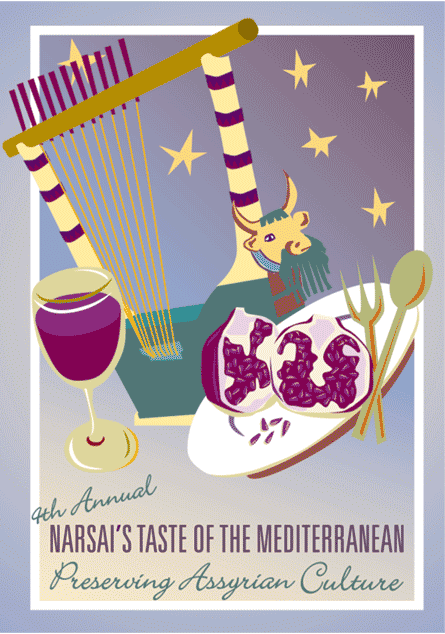 |
As a corporate sponsor of this event, Zinda Magazine is offering special student tickets at $100 (over 65% discount) to full-time Assyrian students with valid proof of enrollment at a high school or college. To obtain your tickets contact Zinda Magazine at narsai2005@zindamagazine.com. Bon apetite ! |
|
The liberation of Iraq in 2003 brought hopes for democracy, equality, justice, and pluralism. There was an Assyrian in the Iraqi Governing Council and a minister in Iraq's first Cabinet led by former Prime Minister Ayad Alawi. There is another Assyrian minister in today's Ibrahim al-Ja'afari cabinet. There are two Christians in the Constitutional Commission writing a draft for the permanent constitution but they are both helpless facing the powerful Shi'aa and Islamist extremists who are determined to make Islam the official religion of Iraq and the Shari'aa as THE source and not A source for legislation and civil law. We may soon be looking at the creation of another Islamic Republic in Iraq, very much like that in neighboring Iran. Did we go to war and lose over 1,800 American lives so that an Islamic republic is established in Iraq?
Since the arrival of the Americans, religious persecution against Assyrian Christians has worsened. Reports indicate that 50,000 Christians have fled Iraq to neighboring Syria and Jordan because Islamists see the Christians of Iraq as collaborators with the "infidel" Americans. From August to October 2004, dozen of churches were bombed and burned in Baghdad and Mosul.
During the January 30, 2005 supposedly democratic elections, the Assyrians were systematically disenfranchised. The International Organization for Migration (IOM), which was responsible for the Out-Of-Country voting process, was bias in the way it selected the polling stations in the U.S. Meanwhile, in Iraq, the elections were manipulated and forged and nothing was done to rectify the situation. Over 100,000 Assyrians did not have the opportunity to vote in Nineveh Plain in north of Iraq, because ballot boxes were not delivered to their areas in timely manner or election officials did not report to their polling centers when the boxes arrived in later time.
More recent problems
- U.S. funding in north of Iraq is not being directed by the Assyrian representatives, but by Kurdish authorities who are systematically bypassing the reconstruction of Assyrian villages. The longest standing Assyrian groups, such as the Assyrian Democratic Movement, are being by-passed.
- Kurdish authorities who are in control over the reconstruction resources are playing the Church against the political and civic institutions, similar to those activities during Saddam's regime. While the Kurds have renovated couple of churches, built one, and appointed certain Christians to cabinet positions in north of Iraq Kurdish regional government, these individuals are members or supporters of the Kurdish organizations and they work for Kurdish interest.
- The Shi'aa are insisting on having the Shari'aa (The Islamic Law) as the main source for legislation and civil law. This means that non-Moslems will be considered as second-class citizens. Women who make 55 to 58% of the Iraqi population would lose hope for equality and other legal matters related to inheritance, right for divorce, custody, etc.
- Kurdish militia are seizing Assyrian villages and replacing abandoned Assyrian homes with Kurdish families brought back from other regions of Iraq and according to some reports from outside Iraq as well.
- Assyrian regions in north of Iraq have been and continue to be penetrated by Kurds. The Kurdish expansion is perceived as a loss of basic security, which is driving the Christians of Iraq to exodus.
- Christian female students are warned to wear Islamic veils upon entering university campuses. Many students have stopped attending classes altogether. Assyrian liquor stores and hair salons are target of bombings and vandalism. Christian children are kidnapped and returned to parents after a large ransom is paid in full.
- Kurds continue to interfere in Assyrian affairs. Certain versions of the Iraqi constitution and north of Iraq Kurdish regional constitution indicate explicit desire to divide the one Syriac-speaking Christians into three distinct groups as Assyrians, Chaldeans, and Syriacs (Suryan) contrary to what was instituted in the Transitional Administration Law, which was suppose to be the foundation for the constitution.
- The two empowered Shi'aa and Kurds are dictating the discussions at all meetings of the Constitutional Committee and all under the watchful eyes of the United States. Drafts of several constitutions by Kurds and Arab groups have referred to Arabs and Kurds as major ethnic groups and the rest as minor.
Suggestions for Consideration
Due to continuous policy of undermining Assyrian existence by Kurds and Arabs and other serious problems arising after the U.S. occupation, Assyrian advocate groups, intellectuals, and civic and political organizations have presented specific demands. Here are some of those demands:
- The U.S. administration should reach out to the legitimate representatives of the Assyrian community, both in Iraq and the United States in order to understand the real volatile situation of the Christians in Iraq.
- Governing authorities should exemplify the desire of separating Church/Mosque and State by directing funding for local governments services through legitimate civic and political bodies instead of clergymen or councils formed under clergymen auspices.
- The U.S., U.S. media, and U.S. civil society should demand accountability of the hundreds of millions of mainly U.S. reconstruction funds that are not being allocated in fair proportion and to the benefit of all Iraqis.
- Given the impact of policies of ethnic cleansing, oppression, persecution and the subsequent exodus that impacted the Assyrians, the constitution should guarantee reserved seats for the Assyrians in all branches of State: Judicial, Legislative, and Executive. Other groups such as the Turkomans, Yezidis, Mandeans, Shabak, etc. should enjoy similar treatment. Additionally, when referring to Iraqi ethnic groups in the constitution, there should not be a classification of some being major while others being minor. All ethnic groups, and religious groups as well for that matter, should be equal.
- The constitution of Iraq must recognize an administrative region for the Assyrians on the land of their ancestors located between the Greater Zab and Tigris rivers under jurisdiction of the central government of Iraq. Other ethnic groups of Iraq should enjoy similar treatment thus no group would feel that it is marginalized at the expense of the other.
- If the constitution is to state that no law should interfere with the Islamic Law of Shari'aa, then a safeguard provision must be added that no law must interfere with all the other religions in Iraq as well. The Islamic Law does not speak about rights; it is rather a system of orders and prohibitions. Therefore, the U.S. government and the international community should invoke universal human rights standards as the basis for a model constitution.
- Establish a two-house system of parliament. Upper and Lower houses, where the Upper will be determined according to population by elections and the Lower to have equal representatives from all religious and ethnic groups of Iraq.
- End all traces of Arabization and Kurdification policies and return all Assyrian lands and villages to their legal owners, their surviving relatives, or local Assyrian institutions. This should include the revision of the current twisted Iraqi history curriculum, which should be written by unbiased committee of scholars and historians.
Final Remarks
Assyrians are the indigenous people of Iraq; Arabs, Kurds, and every other group in Iraq arrived over millennia later. The Assyrians continue to practice linguistic and cultural attributes of their pre-Christian heritage. The Assyrians have been suffering genocide and massacre on two ends: First for being a Christian minority in a Moslem world and secondly for being ethnically Assyrian in a dominant Arab/Kurdish region. For Iraq to become a model state in the Middle East, the fundamentals of democracy must apply equally to all Iraqis. Shi'aa, Sunni, and Kurds alone must not dictate the wording of the constitution or dominate the policy making just because they make a majority and have military power through their militias. If Shari'a or the Islamic Law is adopted as main source of legislation, it will set back America's long-term strategy of strengthening moderate Muslim voices and signal a devastating defeat for President Bush's goals of fostering freedom and democracy in the Muslim world.
Democracy, in its basic form, becomes another form of autocracy if it stops at the limited definition of majority rule. While in a democratic society majority should rule; however, the minority must be protected. In my opinion, neither Shi'aa, Sunni, nor Kurds are ready to be part of a true democratic society or practice democracy without the presence of a reliable system of check and balance. If the Iraqi constitution is to be based solely on the Shi'aa and Kurdish aspirations and ideologies, the Assyrians, the native people of Iraq, will inevitably continue their mass exodus until extinction. The disappearance of the Assyrian Christians from Iraq will the greatest loss to Iraq's rich history.
Thank you.


